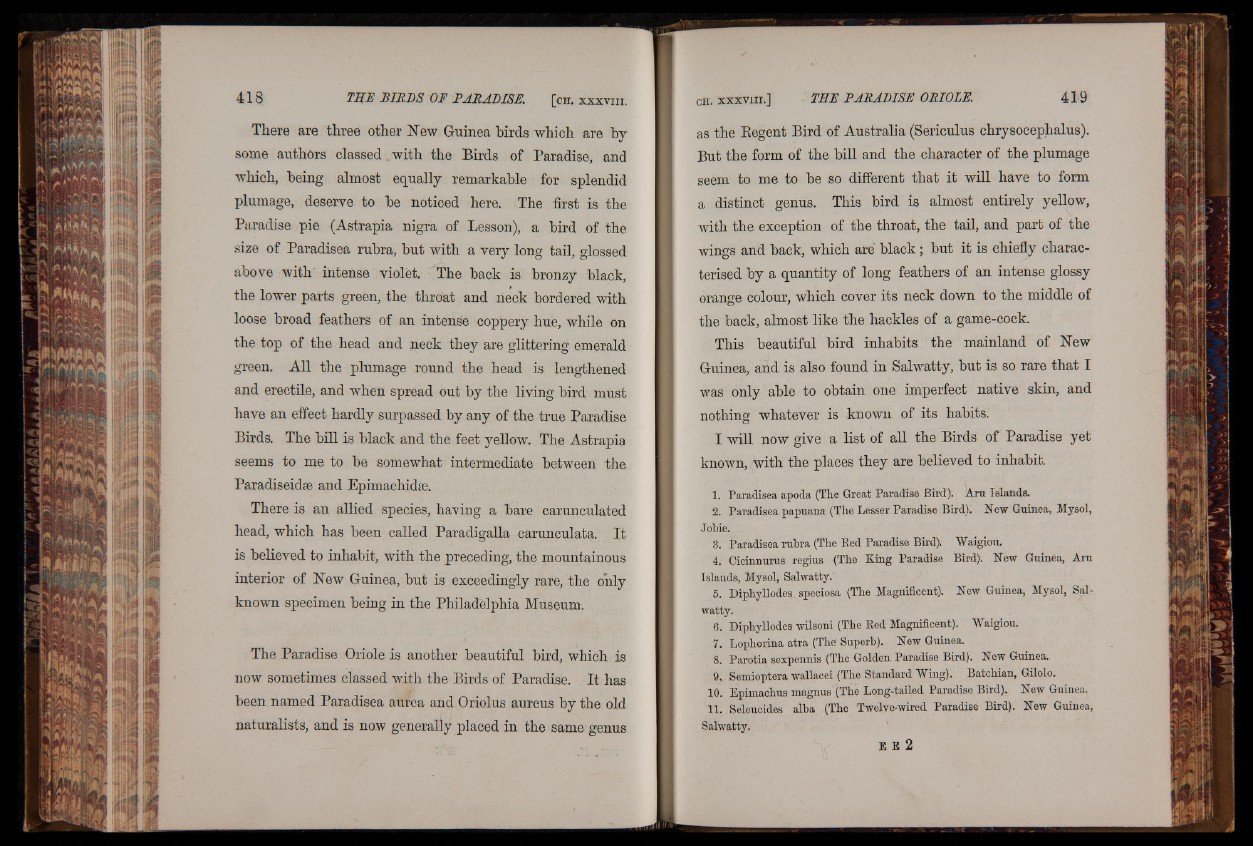
There are three other New Guinea birds which are by
some authors classed. with the Birds of Paradise, and
which, being almost equally remarkable for splendid
plumage, deserve to be noticed here. The first is the
Paradise pie (Astrapia nigra of Lesson), a bird of the
size of Paradisea rubra, but with a very long tail, glossed
above with intense violet. The back is bronzy black,
the lower parts green, the throat and neck bordered with
loose broad feathers of an intense coppery hue, while on
the top of the head and neck they are glittering emerald
green. All the plumage round the head is lengthened
and erectile, and when spread out by the living bird must
have an effect hardly surpassed by any of the true Paradise
Birds. The bill is black and the feet yellow. The Astrapia
seems to me to be somewhat intermediate between the
Paradiseidse and Epimachidse.
There is an allied species, having a bare carunculated
head, which has been called Paradigalla carunculata. I t
is believed to inhabit, with the preceding, the mountainous
interior of New Guinea, but is exceedingly rare, the only
known specimen being in the Philadelphia Museum.
The Paradise Oriole is another beautiful bird, which is
now sometimes classed with the Birds of Paradise. It has
been named Paradisea aurea and Oriolus aureus by the old
naturalists, and is now generally placed in the same genus
as the Begent Bird of Australia (Sericulus chrysocephalus).
But the form of the bill and the character of the plumage
seem to me to be so different that it will have to form
a distinct genus. This bird is almost entirely yellow,
with the exception of the throat, the tail, and part of the
wings and back, which are black; but it is chiefly characterised
by a quantity of long feathers of an intense glossy
orange colour, which cover its neck down to the middle of
the back, almost like the hackles of a game-cock.
This beautiful bird inhabits the mainland of New
Guinea, and is also found in Salwatty, but is so rare that I
was only able to obtain one imperfect native skin, and
nothing whatever is known of its habits.
I will now give a list of all the Birds of Paradise yet
known, with the places they are believed to inhabit.
1. Paradisea apoda (The Great Paradise Bird). Artt Islands.
2. Paradisea papnana (The Lesser Paradise Bird). New Guinea, Mysol,
Jobie.
3. Paradisea rubra (The Eed Paradise Bird). Waigiou.
4. Cicinnurus regius (The King Paradise Bird). Hew Guinea, Aru
Islands, Mysol, Salwatty.
5. Diphyllodes speciosa (The Magnificent). Hew Guinea, Mysol, Salwatty.
6. Diphyllodes wilsoni (The Eed Magnificent). "Waigiou.
7. Lophorina atra (The Superb). Hew Guinea.
8. Parotia sexpennis (The Golden Paradise Bird). Hew Guinea.
9. Semioptera wallacei (The Standard Wing). Batchian, Gilolo.
10. Epimachus magnus (The Long-tailed Paradise Bird). Hew Guinea.
11. Seleucides alba (The Twelve-wired Paradise Bird). Hew Guinea,
Salwatty.
E E 2